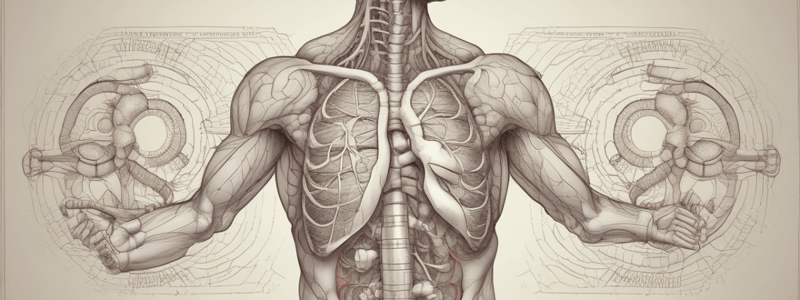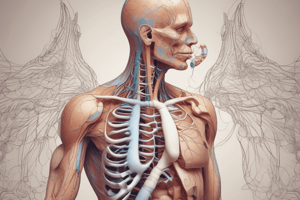Podcast
Questions and Answers
What is the purpose of surfactant secreted in alveolar epithelium?
What is the purpose of surfactant secreted in alveolar epithelium?
- To reduce the expansibility of lungs
- To prevent the collapsing tendency produced by surface tension (correct)
- To increase surface tension on the alveolar membrane
- To stimulate the release of respiratory muscles
What happens to lung compliance when lungs are removed from the thorax?
What happens to lung compliance when lungs are removed from the thorax?
- It decreases
- It remains the same
- It becomes zero
- It doubles (correct)
What is the result of deformities of the thorax on lung compliance?
What is the result of deformities of the thorax on lung compliance?
- Compliance increases
- Compliance remains the same
- Compliance becomes zero
- Compliance decreases (correct)
What is the primary function of the respiratory muscles during quiet breathing?
What is the primary function of the respiratory muscles during quiet breathing?
What is the effect of emphysema on lung compliance?
What is the effect of emphysema on lung compliance?
What is the result of old age on lung compliance?
What is the result of old age on lung compliance?
What is the definition of compliance in the context of lungs?
What is the definition of compliance in the context of lungs?
During quiet breathing, what is the primary process that causes expiration?
During quiet breathing, what is the primary process that causes expiration?
Which pressure is always negative in the respiratory system?
Which pressure is always negative in the respiratory system?
What is the main function of intrapleural pressure?
What is the main function of intrapleural pressure?
What happens to intra-alveolar pressure during inspiration?
What happens to intra-alveolar pressure during inspiration?
Which of the following is NOT a factor that contributes to the collapsing tendency of the lungs?
Which of the following is NOT a factor that contributes to the collapsing tendency of the lungs?
How is transpulmonary pressure calculated?
How is transpulmonary pressure calculated?
What is the role of intra-alveolar pressure in gas exchange?
What is the role of intra-alveolar pressure in gas exchange?
What is the primary reason why the lungs are always inflated?
What is the primary reason why the lungs are always inflated?
Which of these statements accurately describes the relationship between intrapleural pressure and intra-alveolar pressure throughout the respiratory cycle?
Which of these statements accurately describes the relationship between intrapleural pressure and intra-alveolar pressure throughout the respiratory cycle?
What is airway resistance work primarily related to?
What is airway resistance work primarily related to?
What does compliance work specifically address in the context of breathing?
What does compliance work specifically address in the context of breathing?
Physiological dead space includes which of the following?
Physiological dead space includes which of the following?
What represents the volume of normal dead space in the respiratory system?
What represents the volume of normal dead space in the respiratory system?
What effect do respiratory disorders primarily have on dead space?
What effect do respiratory disorders primarily have on dead space?
Which method is used to measure dead space in the respiratory system?
Which method is used to measure dead space in the respiratory system?
In normal conditions, how does physiological dead space compare to anatomical dead space?
In normal conditions, how does physiological dead space compare to anatomical dead space?
Which type of resistance is considered non-elastic in the work of breathing?
Which type of resistance is considered non-elastic in the work of breathing?
What initiates the cough reflex?
What initiates the cough reflex?
Which mechanism effectively prevents respiratory issues during swallowing?
Which mechanism effectively prevents respiratory issues during swallowing?
What is the primary cause of the sneezing reflex?
What is the primary cause of the sneezing reflex?
During a cough, what happens to the intrapleural pressure?
During a cough, what happens to the intrapleural pressure?
What term describes the temporary halt in respiration while swallowing?
What term describes the temporary halt in respiration while swallowing?
What occurs at the end of a cough reflex?
What occurs at the end of a cough reflex?
Flashcards are hidden until you start studying
Study Notes
Pressures in the Thoracic Cavity and Lungs
- Two types of pressures are exerted in the thoracic cavity and lungs during respiration: intrapleural pressure and intra-alveolar pressure.
- Intrapleural pressure is the pressure existing in the pleural cavity, between the visceral and parietal layers of pleura, and is always negative.
- Intrapleural pressure prevents the collapsing tendency of lungs, causes dilation of vena cava and larger veins in the thorax, and keeps the lungs inflated.
- Intra-alveolar pressure is the pressure existing in the alveoli of the lungs and becomes negative during inspiration and positive during expiration.
- Intra-alveolar pressure causes the flow of air in and out of alveoli and helps in the exchange of gases between alveolar air and blood.
Transpulmonary Pressure
- Transpulmonary pressure is the difference between intra-alveolar pressure and intrapleural pressure.
Factors Responsible for Collapsing Tendency of Lungs
- Two factors are responsible for the collapsing tendency of lungs: elastic property of lung tissues and surface tension exerted on the surface of the alveolar membrane by the fluid secreted from alveolar epithelium.
Factors that Save Lungs from Collapsing
- Two factors save the lungs from collapsing: intrapleural pressure, which is always negative, and surfactant secreted in alveolar epithelium, which decreases surface tension on the alveolar membrane.
Compliance
- Compliance is the ability of the lungs and thorax to expand and is defined as the change in volume per unit change in respiratory pressure.
- Compliance is a measure of stiffness of lungs, and stiffer the lungs, less is the compliance.
- Compliance decreases in pathological conditions such as deformities of thorax, paralysis of respiratory muscles, pleural effusion, fibrosis, and abnormal thorax.
- Compliance increases in physiological and pathological conditions such as old age, emphysema, and deformities of thorax.
Work of Breathing
- Work of breathing is the energy obtained during inspiration to overcome three types of resistance: airway resistance, elastic resistance of lungs and thorax, and non-elastic viscous resistance.
- Airway resistance work is the work done to overcome airway resistance, which increases during bronchiolar constriction.
- Compliance work is the energy required to expand lungs and thorax against the elastic force.
- Tissue resistance work is the energy required to overcome the viscosity of lung tissues and tissues of thoracic cage.
Dead Space
- Dead space is the part of the respiratory tract where gaseous exchange does not take place, and the air present in the dead space is called dead space air.
- There are two types of dead space: anatomical dead space and physiological dead space.
- Physiological dead space includes anatomical dead space plus two additional volumes: non-functioning alveoli and alveoli that do not receive adequate blood flow.
- Under normal conditions, physiological dead space is equal to anatomical dead space, and volume of normal dead space is 150 mL.
- Dead space increases in respiratory disorders that affect pulmonary blood flow or alveoli.
Respiratory Protective Reflexes
- Respiratory protective reflexes are the reflexes that protect the lungs and air passage from foreign particles.
- The respiratory protective reflexes are cough reflex, sneezing reflex, and swallowing reflex (deglutition).
- Cough reflex is a protective reflex that occurs because of irritation of the respiratory tract and some other areas, and it begins with deep inspiration followed by forced expiration with closed glottis.
- Sneezing reflex is a protective reflex caused by irritation of nasal mucous membrane, and it starts with deep inspiration, followed by forceful expiratory effort with opened glottis.
- Swallowing reflex (deglutition) is a respiratory protective reflex that prevents entrance of food particles into the air passage during swallowing, and it involves temporary arrest of respiration called apnea.
Studying That Suits You
Use AI to generate personalized quizzes and flashcards to suit your learning preferences.



